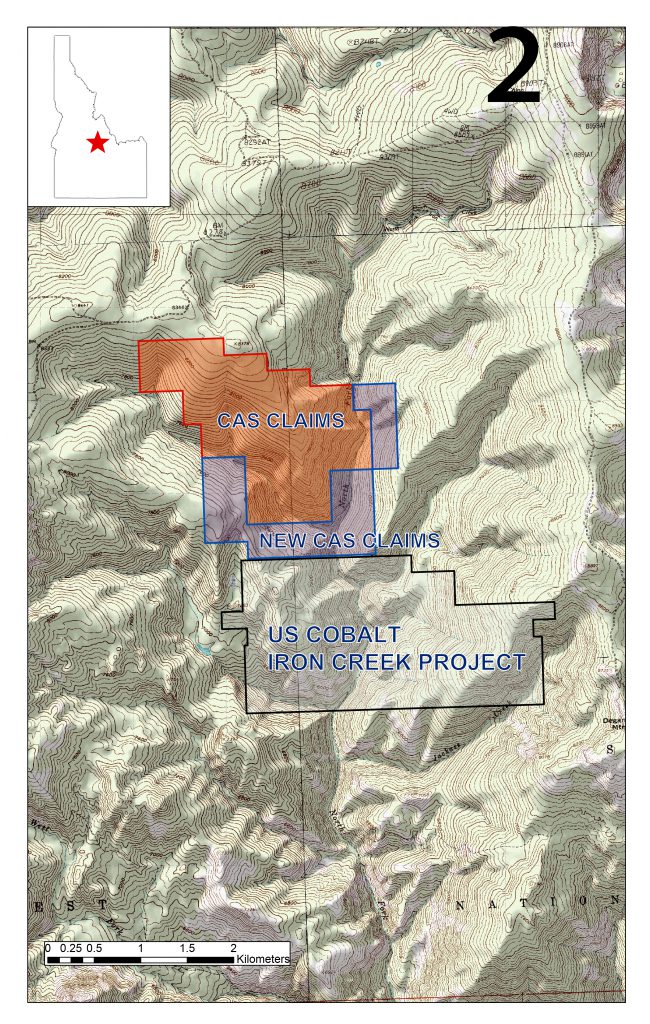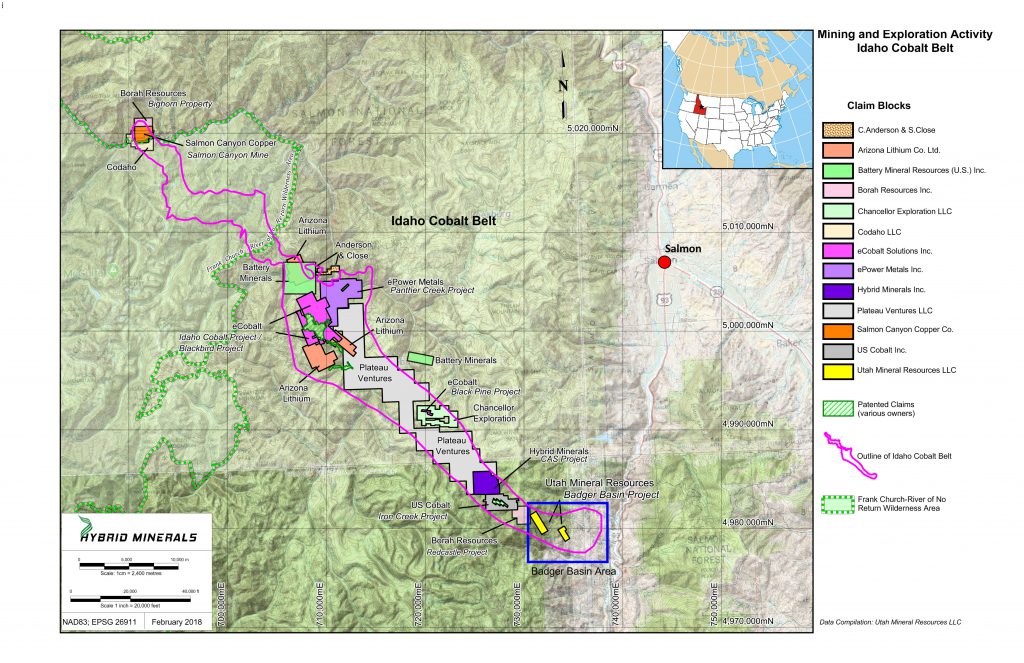THE CAS PROJECT
A High Grade Cobalt/Gold and Copper Opportunity
Hybrid Minerals’ CAS Project represents an excellent opportunity to secure a significant land position in the Blackbird cobalt-copper district within the Idaho Cobalt Belt, which has many known high grade cobalt-copper-gold-rare earth element (REE) deposits. The Belt trends north-westerly and is about 50 km long and 8 km wide. The Blackbird district includes eCobalt’s Blackbird Mine, soon to be the United States’ first pure cobalt mine, International Cobalt’s Blackbird Creek Project and US Cobalt’s (formerly Scientific Metals) Iron Creek Project. The Blackbird district has produced cobalt and copper since the late 1800’s, with total past production and currently estimated resources in excess of ~17 Mt of ore, averaging 0.74% cobalt, 1.4% copper, 1.0g/t gold and REE.
Geology
The Idaho Cobalt Belt is the prime exploration area in the United States to discover large primary cobalt resources. It has been identified by the US Geological Survey and contains several significant cobalt/copper/gold deposits.
- The Blackbird Mine and several other cobalt/copper deposits are located within this belt. The US Geological Survey describes this belt as hosting “copper-cobalt-gold-silver bearing exhalative strata bound zones in micaceous quartzite.”
- The CAS Project lies within the Idaho Cobalt Belt. The Apple Creek Formation hosts the cobalt/copper resources at the Blackbird Mine together with other deposits in the Idaho Cobalt Belt, and this same unit crops is present on the CAS claims.
- Mineral deposits are overall strata-bound and there are both stratiform and vein type deposits. The major ore minerals are cobaltite and chalcopyrite with gold and minor pyrite, arsenopyrite, and pyrite.


Geophysics
Geophysical orientation surveys were conducted on the property over known, exposed copper/cobalt occurrences. These surveys showed a clear relationship between self-potential gradient (SPG) surveys and covered cobalt/copper deposits (anomalies).
- SPG anomalies have been mapped on the property by Richard C, Fox, a geophysicist with extensive mineral exploration experience (and the owner of the claims).
- Prospect pits were dug by hand over some locations of SPG anomalies. Sulfide mineralization was not exposed, but favorable highly altered and mineralized material was encountered.
- The SPG geophysical surveys outline several cobalt/copper drill targets. None of the holes drilled to date were located on the basis of geophysical evidence.
Mineralization
The CAS Project is located in the Salmon Mountain Range, in the Iron Creek Mining District, Idaho, known as the Idaho Cobalt Belt. Historically, mining has focused on stratabound cobalt-copper deposits (e.g. Little No-Name and Blackbird). Mineralization consists of grossly conformable, stratabound quartz pods, silicified veins, zones of tourmaline breccias, sulphide lenses, veinlets and stringers localized along major zones of shearing or deformation and usually in proximity to mafic intrusive rocks. District wide, the mineralization reaches mineable grades and has been mined for cobalt and copper and is anomalous in, arsenic, antimony and bismuth. At the CAS Project the mineralization reaches high grades in gold and cobalt and is anomalous in arsenic, antimony, and bismuth and possibly copper.

Modreski (1985) and Hughes (Nash, 1989) indicate that copper-cobalt-gold mineralization hosted by the Mesoproterozoic Apple Creek Formation clastics represents synsedimentary or volcanogenic massive sulphides formed at, or near, the sea floor. Mineralization is related to rifting within the basin and is contemporaneous with the emplacement of mafic intrusives into the turbidite sequence represented by the Apple Creek Formation.
Exploration at the CAS Project is primarily focused on this style of mineralization.
Fox and Hulen (1999) described gold-cobalt bearing sulfide rich quartz veins and shears hosted by spotted phyllites in the discovery trench and various road cuts. Mineralized veins and shear zones contain quartz veins and stringers with iron carbonate, cobaltiferous pyrite, arsenopyrite, trace chalcopyrite and tourmaline. Trace element indicators are Au, As, Bi, Co, Cu and possibly Sb. There are three known mineralized zones, A, B, and C from North to South respectively, of this style of mineralization. Zone A has been traced for a distance of 2,000 ft on the surface and is up to 300 ft wide. Zone B has been traced for 2,600 ft on the surface and is up to 400 ft wide. Zone C has been traced for 3,400 ft on the surface and averages 150 ft wide.
The composition and style of mineralization is similar to the stringer zone mineralization associated with stratabound copper-cobalt mineralization at the nearby Blackpine Mine, located 10 kilometers to the northwest. Modreski (1985) describes mineralization at Blackpine as comprising pyrite-chalcopyrite-arsenopyrite in veinlets and stringers grossly stratiform within chlorite-biotite-muscovite siltite and quartzite. Cobalt mineralization is also found remobilized along shear zones parallel to bedding and in silicified and tourmalinized breccias at other locations within the Idaho Cobalt Belt.
The cobalt/copper occurrence on the property was discovered in 1967. Recon surface geologic work was conducted by Sachem Corporation (1970-1973), Noranda Exploration (1977-1982), Kinross Gold (1989-2000) and Thunder Mountain Gold (2011). Nevada Contract Corporation (2002-2004) and Salmon River Resources (2005) conducted drilling operations on the property.
Drilling on the property has encountered strong mineral occurrences of cobalt and gold. Results include:
- IC03-03 1.5m @ 0.54% Co and 8.5g/t Au
- IC03-04 4.6m @ 0.34% Co and 8.3g/t Au
- IC03-07 3.0m @ 0.08% Co and 9.2g/t Au
Interpretation and Conclusions
The property is in the early stage of exploration, however, it is concluded from reasonable interpretation of the data, and other relevant information, that the property is of merit and has good potential for the discovery of both high-grade gold-cobalt shoots and lower grade disseminated gold-cobalt mineralization.
The CAS Project is well located in the Idaho Cu-Co-Au mineral trend.
Several mineralized areas on the CAS Project have been explored to varying degrees over the past twenty-five years. The most advanced exploration target is the discovery zone area. Prior exploration on the CAS Project has outlined a geological environment similar to that underlying many of the Cu-Co-Au showings in the area including hosting stratigraphy and mineralization style.
Previous exploration and drilling at the CAS Project was of a preliminary nature. Significant exploration potential exists to expand beyond the present dimensions. Surface exposures of the three known mineralized zones range from a 2,000 ft. strike length on zone A to a 3,400 ft. strike length on zone C. Drilling to date has traced mineralization for a minimum 300 meters (985 feet) of strike-length. Zone C has yet to be drilled.
Exploration Program
A general exploration program is proposed for the CAS Project, which will comprise:
- In the 1st year: data compilation and assessment; trenching; airborne magnetic survey; permitting; preparation of an NI 43-101 compliant report; $300,000 budget.
- In the 2nd year: trenching and sampling; diamond core drilling; assessment of results and selection of targets for follow-up investigation; NI 43-101 Technical report; $300,000 budget.
- In each extension year: diamond core drilling campaigns; sampling of the mineral deposit for grade determination; metallurgical studies and technological testing; mineral resource and reserve modeling; NI 43-101 Technical Report; economic analysis.
Adjustments to this program will be made during the execution of the exploration work, in order to take into consideration results of the program. A more detailed breakdown of work to be done during years 1 & 2 are included.
For more details of the project, download the full report here.
